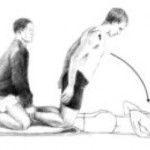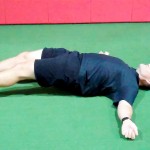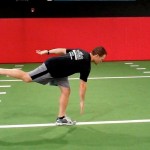Perhaps one of the most researched topics is ACL injuries. I have been studying and working for years in my clinical practice to find the best ways to rehab athletes following injury as well as implement the most effective injury prevention strategies. Prior studies indicate prevention programs even when self directed can be successful.
However, on the whole injury rates have not declined over the past decade or so. Much attention has been given to valgus landing mechanics, poor muscle firing, stiff landings, genetic difference between males and females, ligament dominance, quad dominance, and so forth. The predominant thoughts today for prevention center around neuromuscular training and eliminating faulty movement patterns (refer to work being done by Timothy Hewett and Darin Padua).
We also know from a biomechanical standpoint that the hamstrings play an integral role in preventing excess anterior tibial translation, and as such hamstring strengthening needs to be a big part of the rehab and prevention program. I believe in hamstring training that allows for activation in non-weaightbearing and weight bearing positions. Common exercises I will use include:
- HS bridging patterns (double /single leg, marching, knee extension, stability ball)
- Nordic HS curls
- HS curls (stability ball, TRX or machine)
- Sliders – focus on slow eccentric motion moving into knee extension followed by simultaneous curls/bridge
- Single leg RDL (add dumbbells or kettle bells for more load)
Note: click on any of the thumbnail images above for a full view of the exercise. From left to right: Nordic HS curls, sliding hamstring curls and single leg RDL).
A recent blog post entry by the UNC Department of Exercise and Sport Science (@UNCEXSS) has spurred my post today. Click here to read their entry on optimizing injury prevention based on work done by Professor Troy Blackburn regarding the effect of isometric and isotonic training on hamstring stiffness and ACL loading mechanisms. The research that was done holds promise for hamstring training designed to increased musculotendinous stiffness (MTS).
For those unfamiliar with MTS, think of it is as simply the ability or degree to which the muscle unit is able to restrain load or force relative to a certain movement. In short, this paper revealed that isometric strengthening was more effective than isotonic training in increasing MTS. However, the authors acknowledge their sample size was small, and had it been larger they would have had enough statistical power to report that isotonic training would also have provided statistically significant changes in MTS.
This is important as we look for more effective ways to introduce prevention programming as part of a team warm-up or routine that can be done outside a weight room. The prone methods they used for the isometric training are not feasible on the field or court, but integrating isotonic exercises such as Nordic HS curls or body weight RDLs could easily be done. The study did not compare their methods to eccentric training or endurance exercises, so further study needs to be done in that manner prior to drawing conclusions with respect to those modalities.
Based on my years of training and sports medicine, I feel there are some challenging factors to overcome with respect to ACL injury prevention such as:
- Genetic hyperlaxity (I have a patient now who has torn his ACL 3x on the same side in 20 months doing martial arts and he has excessive recurvatum and loose joints)
- Poor movement patterns (I screen using FMS, drop landing, LESS)
- More year round play = more practice and play increasing exposure to harmful loads/forces as well as neural fatigue and overtraining
- Previous injuries in some athletes including ankle sprains, meniscus tears, prior ACL surgery and collateral ligament sprains
One of my concerns with the use of hamstring autograft reconstructions over the years has been the fact that we take one of the hamstrings and compromise its integrity (strength generation and rotational control) to repair the ACL. I am not convinced my athletes ever fully recover their hamstring strength after this procedure, let alone in 6 months when most are cleared to return to sport. This is not to say I am opposed to its use – I just think our rehab plan and return to play decisions should take this into consideration.
With that said, I am not a fan of using the hamstring graft in someone who had a concomitant grade 2/3 MCL sprain as I feel the medial stability of the knee has been compromised to a certain degree. Unfortunately, I have seen a few ACL reconstructions fail down the road when this approach has been used. I feel it is a risk that most be considered in the younger population planning to return to high impact and cutting sports. This may be even more of an issue in our females who consistently demonstrate 1:2 hamstring to quad ratios to begin with.
Unresolved ankle sprains are a big issue too. Consider that limited dorsiflexion in cutting and deceleration leads to compensatory pronation and internal rotation. This can be a recipe for disaster for the knee joint. It is imperative to restore lost dorsiflexion following lateral ankle sprains and any type of immobilization.
Click here to read a review article by Darin Padua and Michael Clark on the impact limited ankle mobility has on knee injury prevention. The more we learn about our athletes’ movement deficiencies, the better we can help them develop an optimal program for complete rehab and injury prevention.
I look forward to seeing additional research on hamstring stiffness as I do believe it is a critical piece of the neuromuscular puzzle with respect to maximizing knee health. I feel optimizing movement patterns is a must. Common issues I see are limited ankle/hip mobility, poor hip and trunk control, and upright landing/cutting to name a few. We must train the neuromuscular system to resist unwanted motion and execute the right strategies in certain situations. This requires repetitive, intentional training. Efficiency is key when it comes to compliance and learning to do more with less time and equipment will help reduce barriers to implementation.
For some of our athletes, the cards may be more stacked against them than others. We, as medical and fitness professionals, can do incredible things by embracing the fact that “exercise is medicine.” It is up to the researchers, therapists, athletic trainers and performance coaches to continue working together to find the best training methods for each athlete based on sport, injury history, goals and physical limitations/abilities. I can’t wait to see what we can do in the next 10 years!




